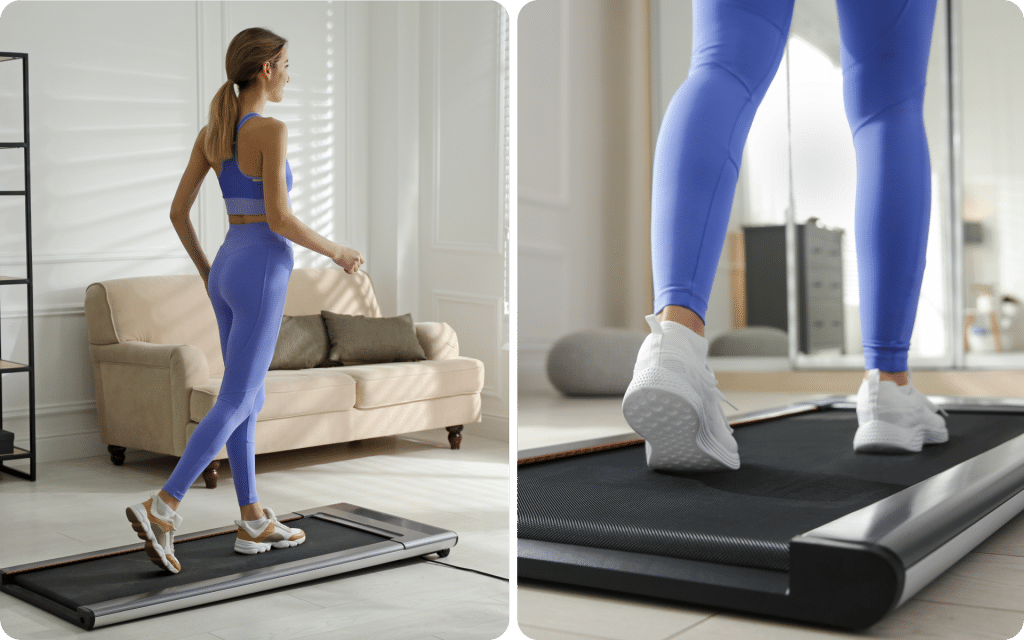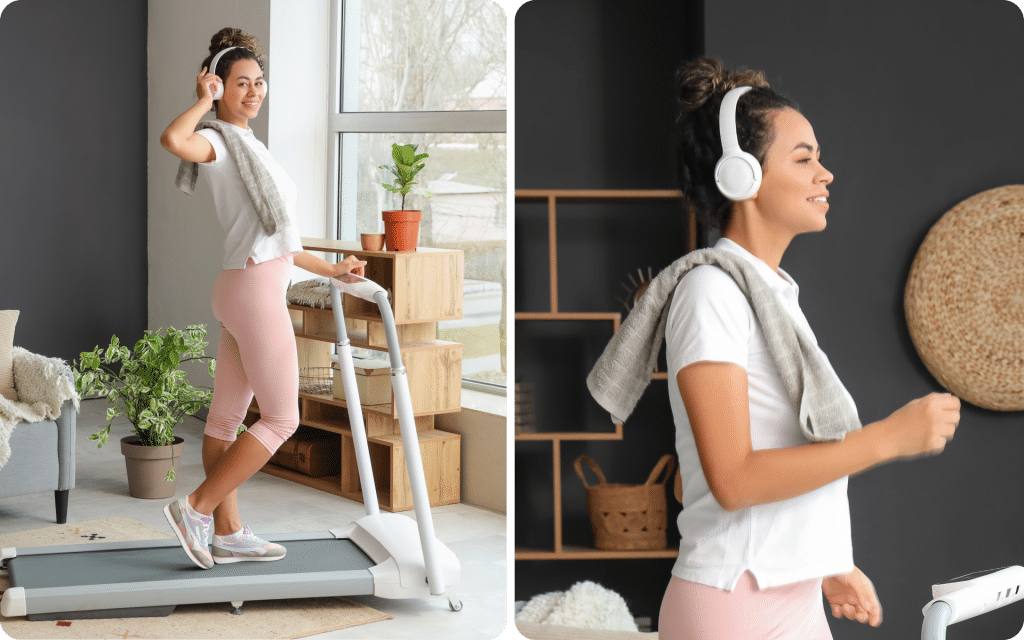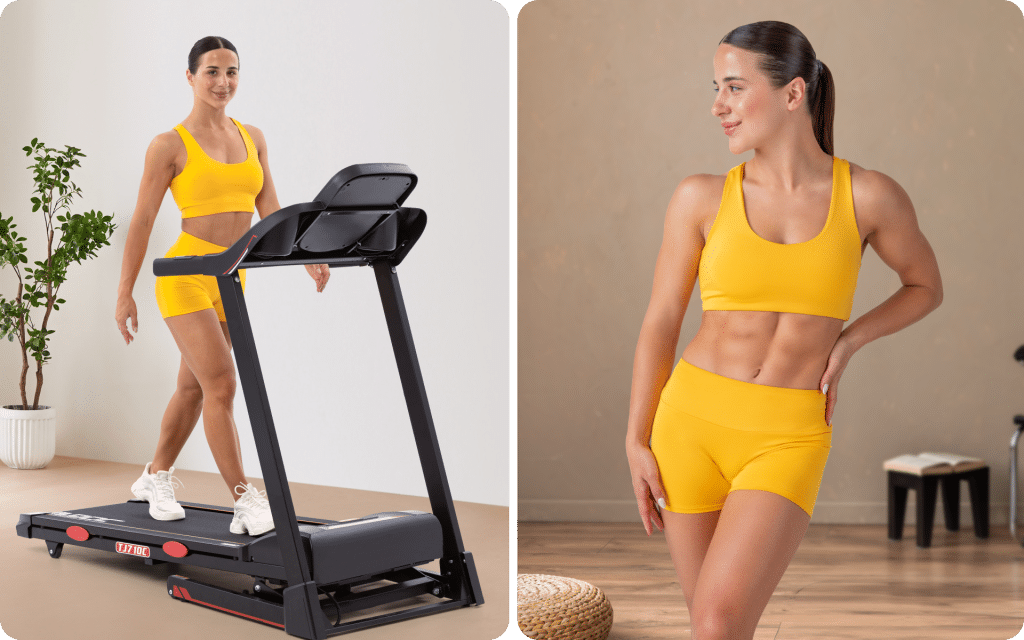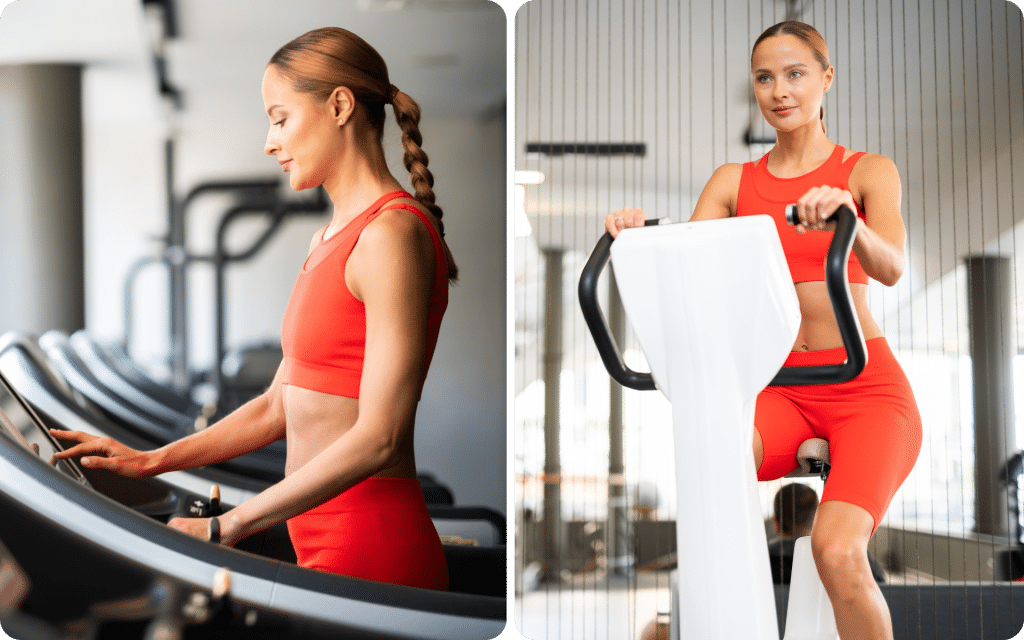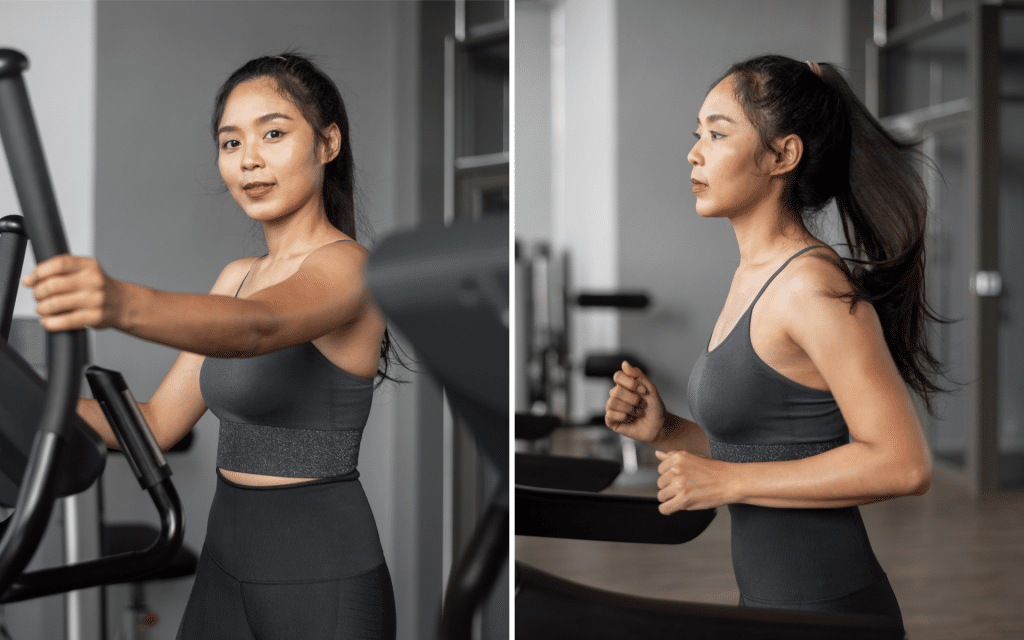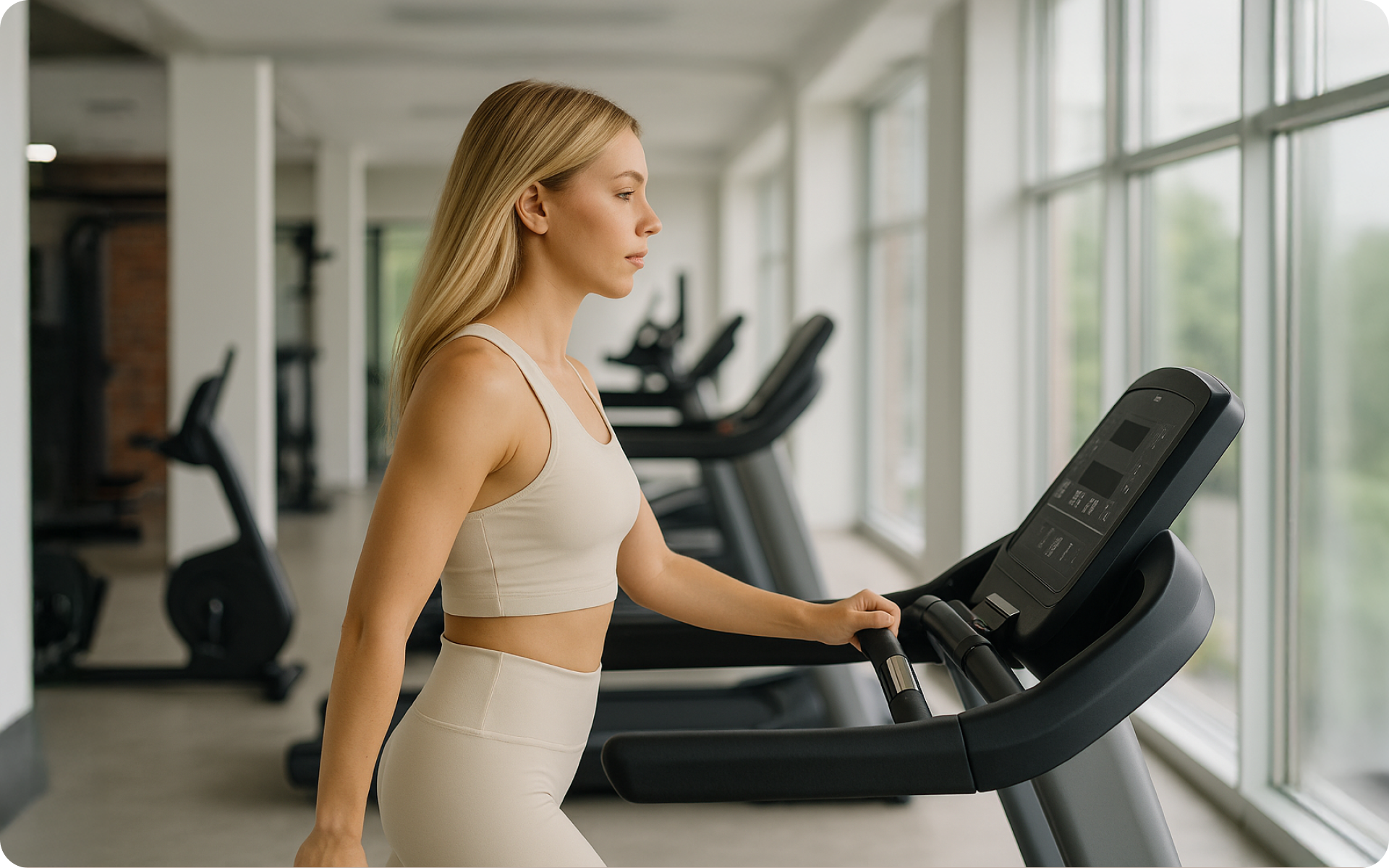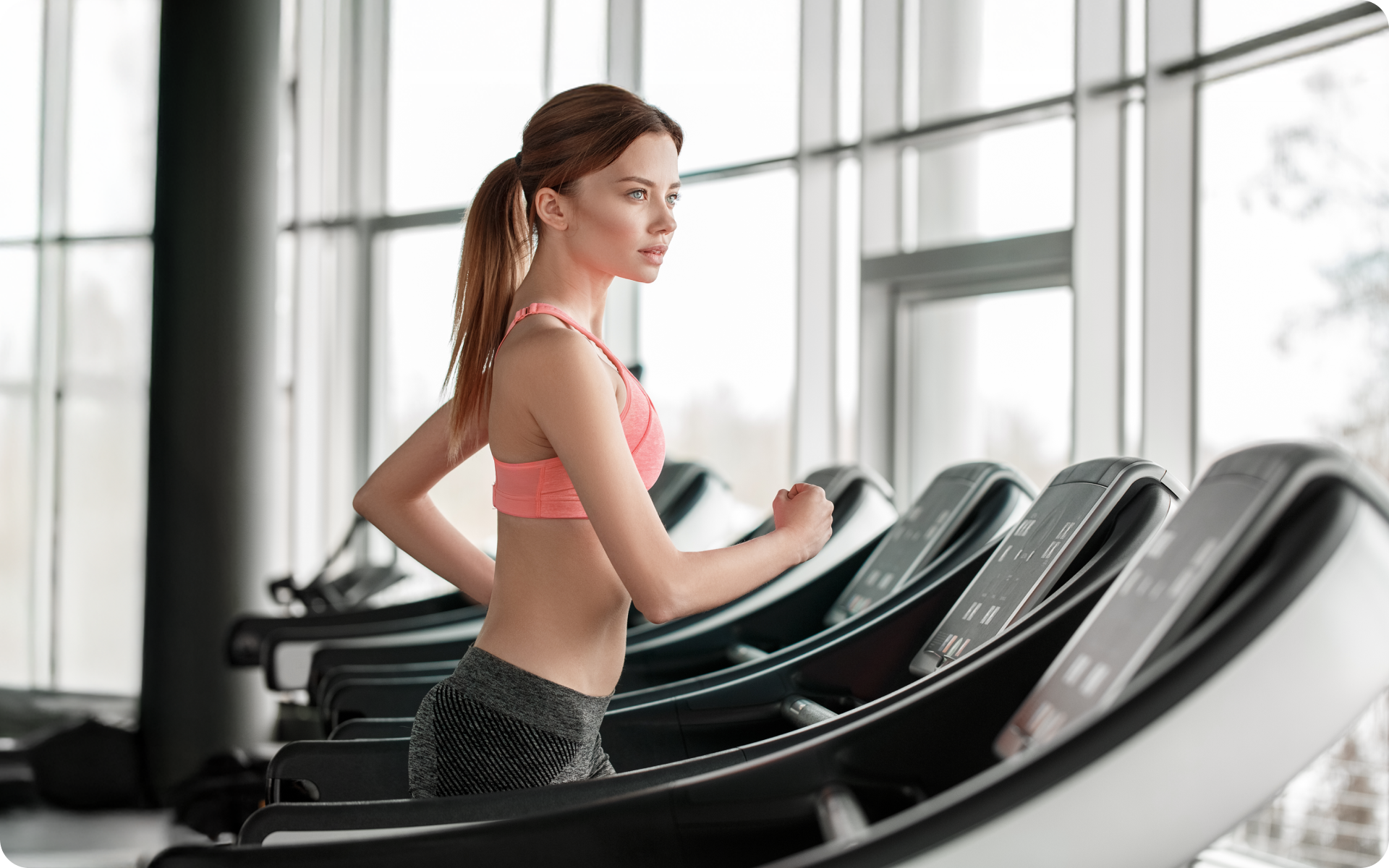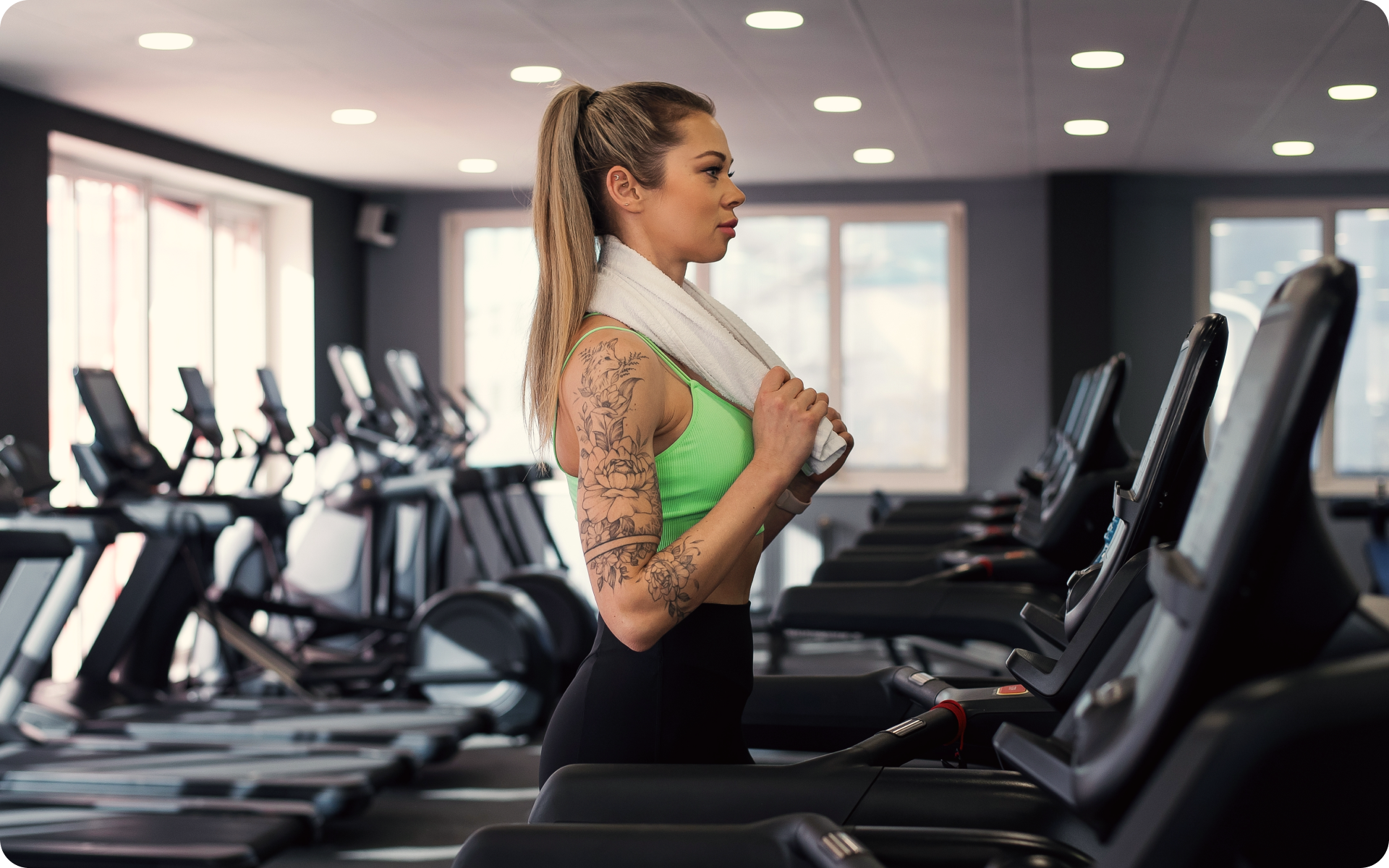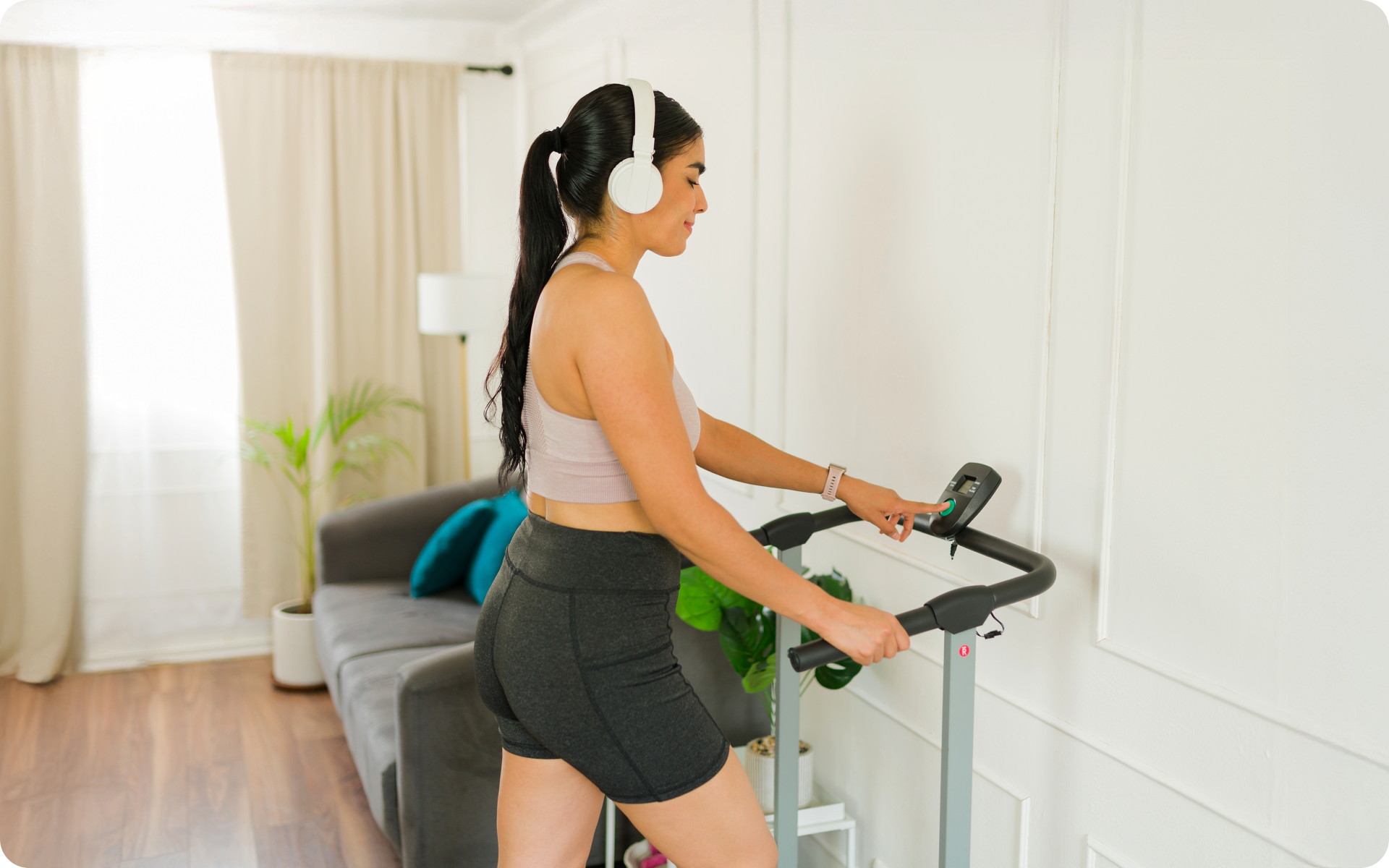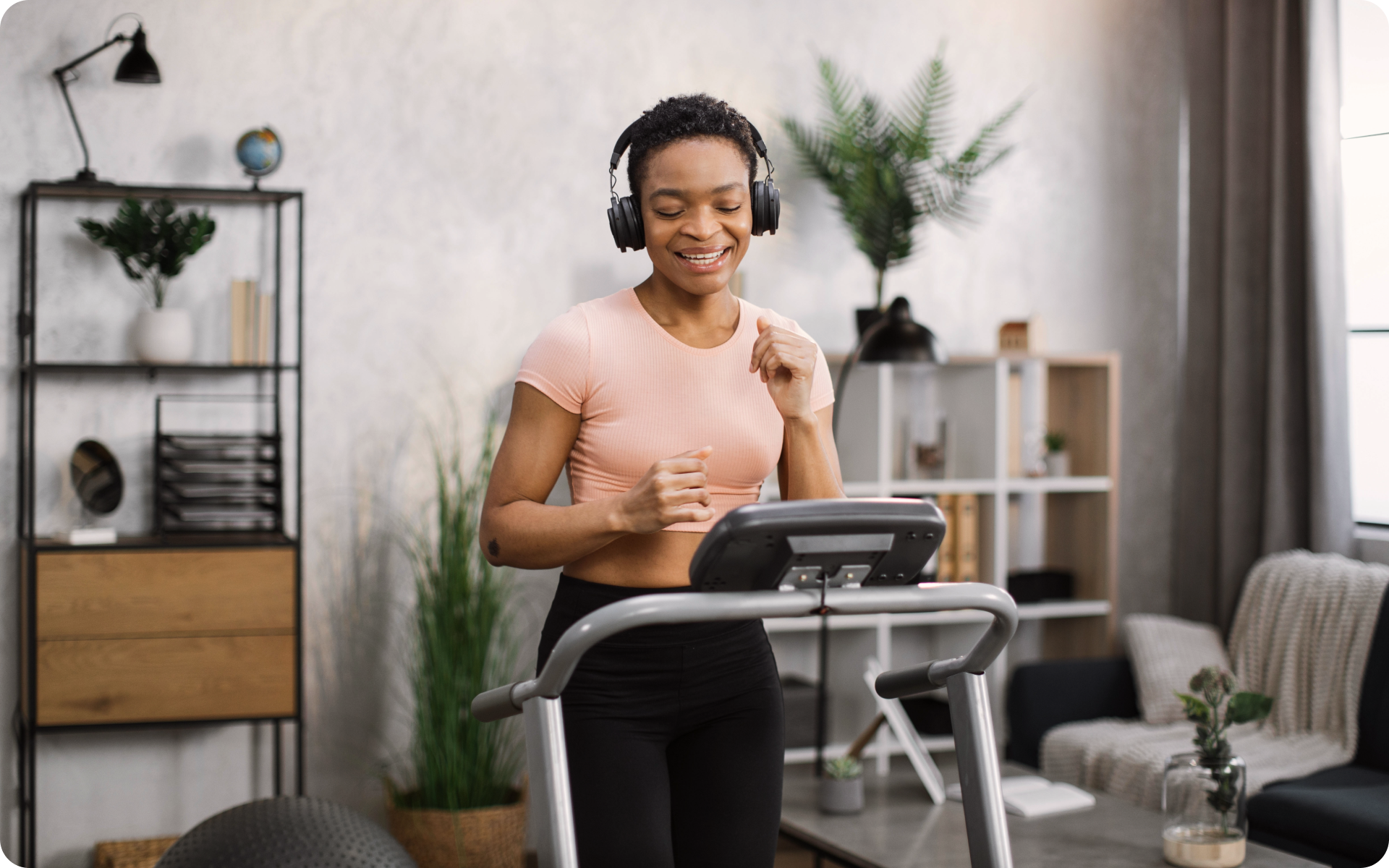Recent recommendations by the American Academy of Orthopedic Surgeons (AAOS) and the American College of Rheumatology (ACR) suggest exercise as one of several knee pain management strategies (1, 2).
They recommend low-impact aerobic exercise, strength training, and neuromuscular education (training that improves the connection between your brain and muscles) to support and strengthen joint health.
However, knee pain and its management come with nuances. While staying active is key, not all forms of exercise are equally suited to everyone, particularly those with knee injuries or conditions such as osteoarthritis.
For example, a treadmill can be a tool for improving cardiovascular health and strengthening muscles, but only if it is used thoughtfully.
Here’s what you need to know about using the treadmill while managing long-standing knee pain or working to prevent future issues.
Can You Fix Bad Knees with Exercise?
While it’s incredibly beneficial, exercise isn’t a cure-all for bad knees. Some issues, such as significant cartilage loss or structural damage, may require medical interventions.
However, in most cases, a carefully designed exercise routine can lead to meaningful improvements in strength, mobility, and overall comfort.
Exercise has an undeniable ability to manage pain, improve function, and sometimes slow the progression of knee problems (3, 4). The key to success is tailoring exercises to your specific condition and being consistent over time.
What Causes Bad Knees?
Bad knees can result from many factors, including injuries such as ligament tears, chronic conditions like osteoarthritis, or long-term wear-and-tear on the joint. The cartilage in the knee naturally wears down as you age, which is why knee pain becomes more common over time (4).
Other contributors include weak muscles, tight connective tissues, and even improper movement patterns during physical activity.
One under-discussed cause of knee issues is inactivity. Being sedentary weakens the muscles that surround the knee, which leaves the joint unstable and less supported (5). This can exacerbate existing problems and even lead to new ones. Exercise combats this through its ability to build strength, enhance flexibility, and improve overall joint health.
How Exercise Can Help
Exercise is often a first-line recommendation for dealing with knee issues. You may wonder why, particularly if moving causes discomfort. However, when it’s done appropriately, exercise equips your body with tools to handle the stress on your joints. Here’s a closer look at its benefits (1):
1. Strengthens Supporting Muscles
The muscles around your knee act like shock absorbers, distributing the forces placed on your joint during daily activities. Strong quadriceps (the muscles at the front of your thigh) and hamstrings (the muscles along the back of your thigh) can significantly reduce the load on your knee. Seated leg extensions, for example, have been found to increase quadriceps strength which can help protect your knee joint from injury.
2. Improves Flexibility
Regularly stretching the muscles around your knee can improve your range of motion and reduce stiffness, which is essential for preventing injuries. Movements that focus on the knees such as lunges and leg presses are great for improving flexibility while also building muscle strength.
3. Increases Stability
Strong muscles around the knee joint can help stabilize and support your knee during daily activities, which reduces the risk of falls or instability. Exercises such as squats and step-ups can improve balance and stability in your knees, making them less prone to injuries.
4. Enhances Joint Lubrication
Exercise can also help improve the lubrication of joints, including your knees. This is because physical activity stimulates the production of synovial fluid, a natural lubricant that helps reduce friction in your joints. With improved joint lubrication, you may experience less discomfort and stiffness in your knees.
5. Helps with Weight Control
Excess weight can put additional stress on your knee joint, which can lead to pain and discomfort. Regular exercise can help manage weight by burning calories and building muscle mass. By maintaining a healthy weight, you can reduce the strain on your knees and potentially prevent future knee problems.
Exercise Types That Support Knee Health
Not all exercise is created equal when it comes to managing bad knees. High-impact activities, such as running or jumping, can worsen pain for some people. Instead, you should focus on gentler movements that protect your joints:
- Low-Impact Aerobic Activities
Walking, swimming, or cycling provide cardiovascular benefits while being kinder to your knees. - Strength Training
Exercises such as leg presses, step-ups, and bodyweight squats (done correctly) can build the muscles supporting the knee. - Flexibility Work
Incorporate stretches for your hamstrings, calves, and hips to maintain mobility. - Balance and Stability Training
Exercises like single-leg stands improve coordination and stability, which reduces the risk of falls or further injury.
Read more: Treadmill Weight Loss: Effective Strategies and Workouts
Is the Treadmill Good for Bad Knees?
The answer here is less black and white and more “it depends”. Whether a treadmill is suitable for your knees hinges on factors such as your specific condition, current level of discomfort, and overall health.
Consulting a doctor or physical therapist is always a safe first step. An individualized approach will ensure you don’t inadvertently worsen any existing problems.
Low-Impact Exercise for Joint Health
Low-impact activities minimize stress on the joints while keeping your heart rate up and improving circulation (6).
Walking on a treadmill at a slower pace with an incline could fall into this category, as it reduces the pounding effect compared to running on a hard pavement (7).
While treadmills offer a controlled environment, they shouldn’t be used in the presence of sharp or severe knee pain. In addition, those with existing knee problems may benefit from starting with lower-impact machines, such as ellipticals or stationary bikes, before incorporating treadmill work.
Reasons why BetterMe is a safe bet: a wide range of calorie-blasting workouts, finger-licking recipes, 24/7 support, challenges that’ll keep you on your best game, and that just scratches the surface! Start using our app and watch the magic happen.
Strength Training as a Complement
Strengthening the muscles surrounding your knees is another important piece of the puzzle. Exercises that target your quadriceps, hamstrings, and calves can reduce knee strain by offering better support to the joint. Resistance-based exercises, such as leg presses, hamstring curls, or bodyweight squats, are often recommended for improving knee stability (8).
When paired with treadmill walking, these exercises can create a well-rounded routine aimed at reducing knee discomfort while strengthening the surrounding areas.
How Do I Strengthen My Knees on a Treadmill?
Using a treadmill can be a safe and effective way to strengthen your knees if done correctly. Strengthening your knees requires focus on proper form, gradual progression, and consistent effort. Below, we’ll break down the important steps to help you safely and effectively support your knee health.
Warm Up Thoroughly
A proper warm-up helps prepare your muscles and joints for the workout, reducing stiffness and the likelihood of injury (9).
- Start with Gentle Movements
Begin your warm-up with 5-10 minutes of dynamic stretches. Dynamic stretches, such as leg swings, walking lunges, or knee hugs, improve blood flow and loosen the muscles around your knees. This is an essential step to reduce joint stiffness and prepare the body for exercise.
- Begin with a Slow Walk
Ease into your treadmill session with a slow, steady pace for the first 5 minutes. This will gently activate your joints and allow synovial fluid to coat and lubricate the knee for smoother movement.
Maintain Proper Form
Adopting correct posture and movement mechanics is essential to minimize unnecessary stress on your knees.
- Stand Tall with Good Posture
Maintain an upright posture throughout your treadmill workout. Keep your shoulders relaxed, your chest upright, and your eyes looking forward. Avoid leaning forward as this can shift undue stress onto your knees, making them work harder than necessary.
- Take Short, Controlled Steps
Aim for shorter strides where your feet land directly under your hips. Avoid overstriding (landing too far ahead), as this can increase the impact forces on your knees. Controlled steps improve efficiency and reduce strain on your joints.
- Wear Supportive Footwear
Choose shoes that are specifically designed for walking or running. Look for sufficient cushioning and arch support, which help absorb impact and reduce stress on the knee joints. Replace worn-out shoes to maintain this protection.
- Adjust Speed and Incline
The speed and incline settings of the treadmill allow for controlled progression, a crucial factor in safely strengthening your knees.
- Start Slow and Progress Gradually
Start at a pace that feels comfortable and pain-free (for many, this is around 1.5 to 3 mph). Avoid increasing your speed too quickly. Gradual progression builds knee strength while minimizing injury risk.
- Use a Gentle Incline
A slight incline (1-2%) mimics natural terrain and engages the muscles around your knees more effectively. It’s a safe way to increase the workload without overwhelming the joint. Steeper inclines should be avoided until you’ve built adequate strength, as they can place excessive stress on your knees.
- Incorporate Interval Training
Once you’re comfortable, add brief intervals alternating between flat and inclined settings. For example, walk on a flat setting for 3 minutes, then switch to a slight incline for 2 minutes. This keeps the workout dynamic and gradually improves endurance and strength in a joint-friendly way.
- Engage Your Muscles
Activating the right muscles helps support your knees and distributes the workload effectively.
- Focus on Using Your Quads and Glutes
Engage your quadriceps and glutes (the muscles at the front of your thighs and in your hips, respectively). These muscles stabilize and protect your knees, which reduces undue strain. Visualize squeezing your thighs and glutes with each step.
- Maintain Core Stability
A strong, stable core prevents excess upper body sway, which can throw off your alignment and lead to unnecessary knee stress. Keep your abdominal muscles lightly braced as you walk.
Cool Down and Stretch Post-Workout
Just as warming up is important, cooling down helps transition your body to a resting state and addresses any post-exercise stiffness (9).
- Gradually Lower Your Walking Speed
Spend 5 minutes walking at a slower pace at the end of your treadmill workout. This helps reduce your heart rate gradually and gives your knees time to decompress safely.
- Stretch Key Muscle Groups
Focus on stretching the quadriceps, hamstrings, calves, and hip flexors after your session. For example:
- Standing Quad Stretch: Hold onto a stable surface, bend one leg, and pull your heel toward your glute. Keep your knees close together to properly stretch one thigh at a time.
- Hamstring Stretch: Take a seat on the ground with your legs extended out in front of you. Reach both of your hands forward and try to touch the tips of your toes. Pause for 3-4 seconds and breathe in and then out as you stretch your arms further toward your toes. You should feel a stretch behind the thigh in both legs.
- Hip Flexor Stretch: Step one foot forward into a lunge position and sink your hips straight down to stretch the front of your hip and thigh.
Monitor Progress and Listen to Your Body
Strengthening your knees is a gradual process. Overworking your joints too soon can do more harm than good.
- Pay Attention to Pain Signals
While mild soreness is normal when building strength, sharp or worsening pain isn’t a good sign. Stop the activity and consult a professional if the pain persists.
- Incorporate Rest Days
Recovery is just as important as exercise. Aim for 2-3 treadmill sessions per week and ensure adequate rest days in between. This will give your muscles time to repair and grow stronger.
- Seek Professional Guidance
If you’re dealing with chronic knee pain or specific injuries, work with a physical therapist or certified trainer. They can guide you through customized workouts that address your unique needs and ensure correct movement patterns.
Read more: 28-Day Treadmill Weight Loss Challenge for Beginners
What Are the Best Treadmill Exercises That Are Good for Knees?
Below are some of the best treadmill exercises for supporting knee health, together with tips on how to perform them safely.
- Walking at a Comfortable Pace
Walking is low-impact, easy to control, and strengthens the muscles around your knees without causing strain.
Start at a moderate pace – usually between 2.5 and 3.5 mph, depending on your comfort level. Aim for an upright posture with relaxed shoulders, and take short steps to minimize joint impact. Ensure your feet land softly with each step.
- Incline Walking
Adding a slight incline to your treadmill workout engages the muscles around your knees more intensively, particularly your quadriceps and glutes, which are essential for knee support. The incline also reduces the force of direct impact compared to walking on a flat surface (7).
Set the treadmill incline to around 2-3% to start. Walk at a moderate pace and focus on maintaining good form. Keep your steps controlled and avoid leaning forward excessively, as this can shift stress onto your knees.
- Reverse Walking
Reverse walking reduces the pressure on your knee joint while improving muscle balance and coordination. Working the hamstrings more offsets the dominance of the quadriceps, which can sometimes contribute to knee issues (10, 11).
Reduce the speed to 1-1.5 mph and hold onto the handrails for balance as you face the rear of the treadmill. Take slow, deliberate steps backward, focusing on engaging your hamstrings.
Only attempt this if you’re confident in your coordination.
Why Do My Knees Hurt After Using the Treadmill?
Knee pain after using a treadmill can be frustrating and may stem from various factors. While some issues are temporary or related to your workout habits, others may indicate underlying conditions.
You’re Using the Wrong Shoes
Wearing improper footwear is one of the most common causes of knee discomfort after treadmill workouts. Shoes with insufficient cushioning or arch support fail to absorb the shock from each step, which increases the stress on your knees. Worn-out or ill-fitting shoes can also alter your gait, leading to joint pain (12).
Invest in high-quality running or walking shoes designed for your foot type, and replace your shoes every 300-500 miles to maintain proper support.
Your Form Needs Adjustment
Improper treadmill form can place excess strain on your knees, leading to soreness or pain. Common form issues include overstriding, locking your knees, or leaning excessively forward or backward. These habits disrupt the natural alignment of your joints, increasing stress on the knees. Take short, controlled steps, aim to land your feet under your hips, and maintain an upright posture with relaxed shoulders for better support.
You’re Skipping Warm-Up
Jumping straight into an intense treadmill session without warming up can shock your muscles and joints. Without a proper warm-up, the muscles around your knees may be too tight or stiff to function optimally. This limits joint support, which makes them prone to strain. Start your workouts with 5-10 minutes of dynamic stretches, such as leg swings or walking lunges, and follow with slow-paced walking on the treadmill to prepare your knees for the activity ahead.
You’re Overdoing It
Pushing too hard, too soon can overload your joints, particularly if your body isn’t ready for the intensity or volume. Sudden increases in speed, incline, or workout duration place a heavy load on your knees. High-impact movements such as running can amplify these forces. Start with manageable workouts and progress gradually. Increase treadmill speed or incline by no more than 10% weekly, and ensure you’re giving your knees adequate time to adapt.
BetterMe: Health Coaching app helps you achieve your body goals with ease and efficiency by helping to choose proper meal plans and effective workouts. Start using our app and you will see good results in a short time.
You’re Using Too Much Incline
While incline settings boost muscle engagement, overusing them can strain your knees. Walking or running on a steep incline repeatedly shifts more pressure to the front of your knee joint. To avoid this, stick to a moderate incline of 1-3%, unless your knees are already well-conditioned. Avoid long stretches at steeper inclines until you’ve built enough joint strength.
You May Have Muscle Weakness or Imbalances
Weakness or imbalance in the muscles that support your knees can make treadmill workouts harder on your joints. The quadriceps, hamstrings, glutes, and calves collectively protect and stabilize the knees. If one group is weak or overused, your knees may take on more stress. Include strength training exercises such as bodyweight squats, lunges, and glute bridges in your routine to build balanced muscular support.
You’re Ignoring Pre-Existing Conditions
Knee pain might not always be linked to treadmill use. Pre-existing conditions such as arthritis, tendinitis, or past injuries can make your knees more sensitive during workouts.
High-impact movements can aggravate these conditions, or the pain may signal an undiagnosed issue such as runner’s knee or IT band syndrome. If you suspect an underlying condition, consult a healthcare professional to diagnose the problem and adjust your routine accordingly.
You’re Not Stretching Afterward
Skipping post-workout stretches can leave your muscles tight and stressed, which pressures your knees in future sessions. Tight muscles, particularly in the hamstrings, calves, or quads, pull on the knee joint and throw off its alignment.
Spend 5-10 minutes after your workout stretching key muscle groups such as the quadriceps and hamstrings to release tension and promote flexibility.
You’re Not Giving Your Knees Enough Rest
Overtraining doesn’t allow your knees the recovery time they need. Repeated treadmill sessions without rest days can lead to overuse injuries. Your muscles, tendons, and cartilage need time to adapt and strengthen between workouts.
Aim for 3-4 treadmill sessions per week and complement them with low-impact cross-training activities like swimming or cycling to give your knees a break.
Should I Wear Knee Support on the Treadmill?
Knee supports can provide added stability and support during treadmill workouts. However, they may not address the root cause of your discomfort. Relying too heavily on them without addressing underlying issues such as muscle imbalances or poor form could lead to further problems.
It’s always best to consult a healthcare professional, such as a doctor or physiotherapist, to determine whether knee support is appropriate for your situation. They can assess your specific needs and provide recommendations tailored to your condition, which will help you exercise safely and effectively.
Yes, a treadmill can be suitable for bad knees if it’s used properly. Opt for low-impact activities such as walking and consider using a treadmill with cushioning to reduce joint stress. Avoid high speeds or steep inclines, and consult a medical professional if you have significant knee issues. Manual treadmills can be harder on the knees as they require more effort to move the belt, particularly at higher inclines. This extra strain may increase joint stress. If you have knee problems, a motorized treadmill with cushioning is a better option. A treadmill is often gentler on the knees than outdoor surfaces such as concrete or asphalt. Most treadmills are designed with shock absorption features that reduce joint impact, which makes them a better choice for people with knee concerns. Yes, 30 minutes of treadmill exercise can be sufficient for improving overall fitness and supporting knee health, depending on your intensity level. Walking or light jogging is particularly effective for those who are focused on minimizing joint strain. Adjust your workout to match your fitness goals and physical condition.Frequently Asked Questions
Is a treadmill OK for bad knees?
Is a manual treadmill bad for the knees?
Is the treadmill better than outside for knees?
Is 30 minutes on the treadmill enough?
The Bottom Line
Is a treadmill good for your knees? Yes, it can be an effective and joint-friendly tool when it’s used correctly. By focusing on low-impact exercises, using proper form, and choosing shoes with good cushioning, you can protect your knees while staying active. Listening to your body and addressing pain early are important steps for preventing injuries.
DISCLAIMER:
This article is intended for general informational purposes only and does not serve to address individual circumstances. It is not a substitute for professional advice or help and should not be relied on for making any kind of decision-making. Any action taken as a direct or indirect result of the information in this article is entirely at your own risk and is your sole responsibility.
BetterMe, its content staff, and its medical advisors accept no responsibility for inaccuracies, errors, misstatements, inconsistencies, or omissions and specifically disclaim any liability, loss or risk, personal, professional or otherwise, which may be incurred as a consequence, directly or indirectly, of the use and/or application of any content.
You should always seek the advice of your physician or other qualified health provider with any questions you may have regarding a medical condition or your specific situation. Never disregard professional medical advice or delay seeking it because of BetterMe content. If you suspect or think you may have a medical emergency, call your doctor.
SOURCES:
- Knee Exercises (2009, orthoinfo.aaos.org)
- Exercise & Arthritis (2023, rheumatology.org)
- Nonsurgical Management of Knee Pain in Adults (2015, aafp.org)
- Chronic knee pain (2024, ncbi.nlm.nih.gov)
- Cross-sectional analysis of self-reported sedentary behaviors and chronic knee pain among South Korean adults over 50 years of age in KNHANES 2013-2015 (2019, ncbi.nlm.nih.gov)
- Aerobic Activity in Prevention & Symptom Control of Osteoarthritis (2012, ncbi.nlm.nih.gov)
- The influence of incline walking on joint mechanics (2014, pubmed.ncbi.nlm.nih.gov)
- Knee Conditioning Program (2018, orthoinfo.aaos.org)
- Warm Up, Cool Down (2024, heart.org)
- Backward Walking Training Improves Knee Proprioception in Non Athletic Males (2017, researchgate.net)
- Effects of lower body positive pressure treadmill on functional improvement in knee osteoarthritis: A randomized clinical trial study (2021, ncbi.nlm.nih.gov)
- Testing the effects of footwear on biomechanics of human body: A review (2025, sciencedirect.com)

